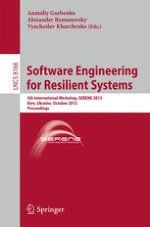2013 | Book
Software Engineering for Resilient Systems
5th International Workshop, SERENE 2013, Kiev, Ukraine, October 3-4, 2013. Proceedings
Editors: Anatoliy Gorbenko, Alexander Romanovsky, Vyacheslav Kharchenko
Publisher: Springer Berlin Heidelberg
Book Series : Lecture Notes in Computer Science
